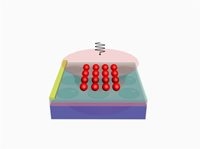Dec 5 2018
In 2017, over 100 food recalls were issued in the US because of contamination from harmful bacteria such as Listeria, E. coli, or Salmonella. A new sensor design could, in the future, make it easier to spot pathogens in food before products reach the supermarket shelves, thus preventing sometimes-fatal illnesses from contaminated food.
 (Image credit: Bing-Gang Xiao, China Jiliang University)
(Image credit: Bing-Gang Xiao, China Jiliang University)
In the journal Optical Materials Express, scientists describe a new design for a sensor that can concurrently detect many substances including hazardous bacteria and other pathogens. As well as food safety, the new design could enhance detection of chemicals and gases for a broad range of other applications.
“Our design is based on graphene sheets, which are two-dimensional crystals of carbon just one atom thick,” said research team member Bing-Gang Xiao, from China Jiliang University. “The sensor is not only highly sensitive but can also be easily adjusted to detect different substances.”
Sensing with graphene
The superior electronic and optical properties of graphene make it appealing for sensors that use electromagnetic waves called plasmons that transmit along the surface of a conducting material in reaction to light exposure. A substance can be detected by measuring how the refractive index of the sensor varies when a substance of interest is near the graphene’s surface.
Scientists have exploited graphene’s exclusive properties to develop sensors and materials for a range of applications in the last few years. In contrast to metals like silver and gold, graphene displays stronger plasmon waves with extended propagation distances. Furthermore, the wavelength at which graphene is responsive can be altered by applying a polarization voltage rather than recreating the entire device. However, few earlier research efforts have shown sensitive graphene sensors that function with the infrared wavelengths essential to detect bacteria and biomolecules.
For the new sensor, the scientists used theoretical calculations and simulations to engineer an array of nanoscale graphene disks with each containing an off-center hole. The sensor comprises of ion-gel and silicon layers that can be used to apply a voltage to tweak the graphene’s properties for detection of different substances.
The interaction between the disks and their holes forms what is referred to as the plasmon hybridization effect, which increases the device’s sensitivity. The hole and the disk also produce different wavelength peaks that can each be used to detect the presence of various substances at the same time.
Simulations performed by the scientists using mid-infrared wavelengths revealed that their new sensor platform would be more sensitive to substances found in solids, liquids, or gases than using discs without holes.
The scientists are currently involved in improving the process that would be used to create the array of nanoscale discs. The accuracy at which these structures are built will significantly influence the performance of the sensor.
“We also want to explore whether the graphene plasmon hybridization effect could be used to aid the design of dual-band mid-infrared optical communication devices,” said Xiao.